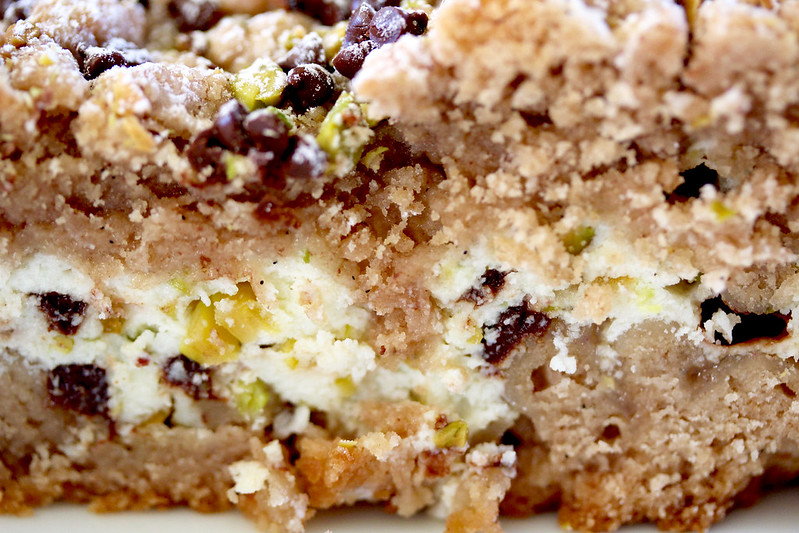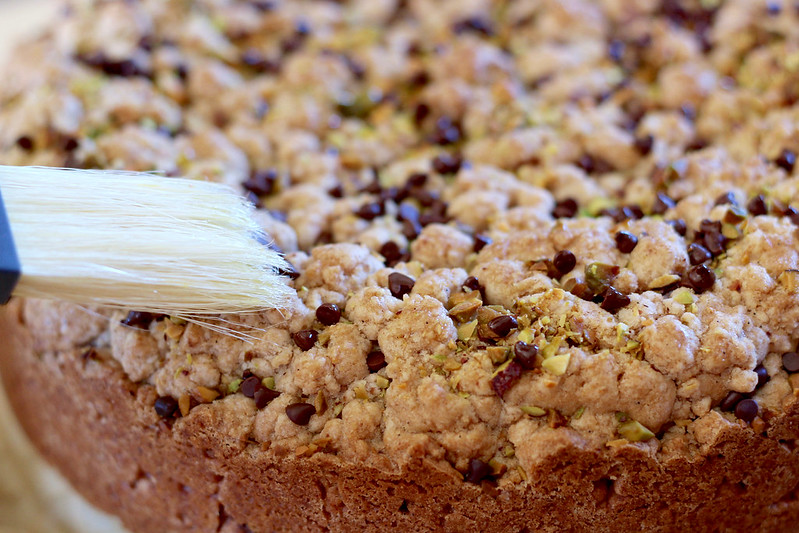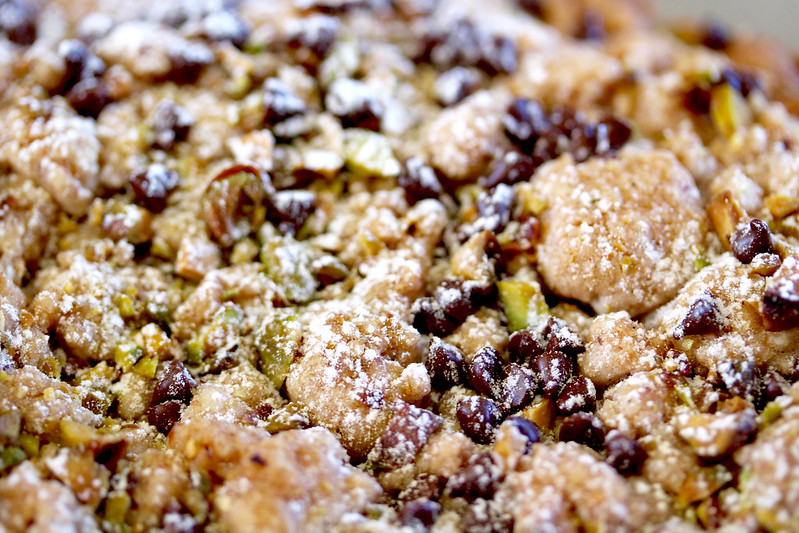
What I wouldn’t give to celebrate the holidays in Italy one of these years! Italy celebrates countless festivals all year round (religious, cultural, national, regional, local– you name it), but I think nothing matches the merrymaking around December/January. In addition to various feasts before and during Christmas, Italians celebrate New Year’s in a big way, which is to say, with lots of traditions and, of course, food. You’ll find plenty of public festivities, such as fireworks and street performers, and many people kick off the evening with a cenone di capodanno, or multi-course celebratory New Year’s meal (the word ‘cenone‘ means ‘big dinner’ and ‘capodanno‘ is the term for New Year, literally ‘head of the year’). Foods served for capodanno dinner are those that traditionally symbolize prosperity and abundance, such as lentils (shaped like coins) and cotechino pork sausage, respectively.
For dessert, to be honest, I couldn’t find a whole lot of consistency. (If anyone can point me in the direction of some reliable sources on this, I would be most grateful.) For some reason, I really like cannoli around New Year’s– I find it festive and special and indulgent. I mean, there are precisely zero times of year that I do not like to eat cannoli, but I seem to gravitate towards it as a New Year’s dessert. Chocolate chips, pistachios, and sparkling candied orange peel seem to be a great way to ring in the new year, no?? However, after eating cannoli *in* Sicily a few summers ago (the region where cannoli originate), I don’t feel like I can offer anything better than that here; there is simply no way that any cannoli recipe I make will hold a candle to the real deal. What I can offer you are delicious cannoli-flavored things. A couple of years ago I made Smitten Kitchen‘s Cannoli Pound Cake, and ever since, I’ve been experimenting with the likes of cheesecake, babka, and other pastries that take well to flavor variations. One of my favorite Italian desserts is torta sbriciolata (sbree-cho-LAH-tah), a simple Italian crumb cake that hails from the northern region of Lombardia, which can be filled with pretty much anything creamy. Since ricotta tends to be a fairly popular filling, I thought that this cake would be an ideal vehicle to transform into a cannoli-inspired dessert by adding the requisite chocolate chips, pistachios, candied orange, marsala wine, and olive oil; and so Torta Sbriciolata alla Sicilia was born (which basically means ‘in the style of Sicily’). I imagine that Sicilians may turn up their noses at this clear bastardization of the sacred manna that is cannoli, but I realized that I really like Things That Taste Like Cannoli But Are Not Actually Cannoli. In case you do too, I hope you find this to be a playful and delicious ode to Sicily’s best-loved dessert!
A few ingredient notes:
- Ricotta: Good quality ricotta is very important here. I highly recommend fresh ricotta, such as Bellwether Farms Whole Milk Basket Ricotta if you live in the San Francisco Bay Area, or something similar. Fresh ricotta must be drained of its liquid and is a very different product than what is labeled “ricotta” and sold in plastic tubs. It will kind of rock your cheese world the first time you try it!
- “Type 00” Italian flour: This is a finely milled flour used for pasta, pizza, and pastry doughs, which you can generally find at well-stocked supermarkets.
- Paneangeli: The recipe calls for a vanilla-scented Italian leavening powder called Paneangeli (literally ‘bread of angels’), which is easily found on Amazon. If you currently bake or plan to bake a lot of Italian desserts, it’s a worthwhile investment. However, if this is a one-shot deal for you, you can probably substitute regular American baking powder. This should work fine, though I have not actually tried it myself.
- Cocoa powder: I used TCHO Natural Cocoa Powder here, which does not go through the Dutching/alkalizing process. While I use Dutch-processed dark cocoa in most recipes that call for cocoa powder, the dough here is not meant to be super-chocolaty. Like cannoli dough, you want just a hint of cocoa flavor, so choose something on the lighter side (whatever brand you’re partial to).
Lastly… if you’ve been reading this blog during 2017, you may remember that I started posting my Italian desserts series recently. I have tapered off because of a busy Fall/Winter baking season, but I will pick this back up again in January. This particular recipe is not part of that series because it isn’t really an authentic Italian recipe– more like an Italian-inspired mashup. But yes, there will be many more actual Italian recipes coming soon… because I can never get enough of Italy and its endless culinary delights! In the meantime, I hope you enjoy this cake to usher in 2018!
Torta Sbriciolata alla Sicilia (Italian Crumb Cake)
Yields 12-16 servings
Remember to drain the ricotta a day ahead. Place it in a fine-mesh sieve set over a bowl, cover it, and leave it in the fridge until you’re ready to make the filling.
For the dough:
- 500 grams (4 cups + 2 tablespoons) “Type 00” Italian flour
- 1 tablespoon natural cocoa powder, sifted
- 2 teaspoons Paneangeli Italian vanilla leavener, sifted
- 1 teaspoon kosher salt
- ½ teaspoon ground cinnamon
- 200 grams (1¾ sticks/14 tablespoons) cold unsalted butter, cut into cubes
- Seeds scraped from 1 vanilla bean
- 300 grams (2 ⅔ cups) confectioners’ sugar
- 2 large eggs, lightly beaten
- 1 tablespoon sweet Marsala wine
For the ricotta filling:
- 550 grams (2¼ cups + 2 tablespoons) fresh whole-milk ricotta, drained for at least 24 hours (see notes above)
- 100 grams (¾ cup plus 2 tablespoons) confectioners’ sugar
- 45 grams (⅓ cup) chopped pistachios
- 85 grams (½ cup) mini chocolate chips
- 20 grams (¼ cup) finely chopped candied orange peel
On top:
- 2 tablespoons micro or mini chocolate chips
- 2 tablespoons chopped pistachios
- Olive oil for garnish
- Confectioners’ sugar for garnish
Make the crumb dough:
Place the flour, cocoa powder, Paneangeli leavener, salt, and cinnamon in the bowl of a food processor and pulse a few times until combined. Add the cold butter cubes and vanilla bean seeds and pulse until the mixture has a uniformly sandy texture. (You do not want large butter chunks like a pie crust.)
Transfer the crumbs to a large mixing bowl. Add the confectioners’ sugar and toss with your hands until it is evenly incorporated into the flour/butter mixture; make a well in the center. Add the eggs and Marsala wine and toss gently with your hands for several minutes, until the dough forms clusters that are mostly about the size of hazelnuts (some smaller and a few larger are fine). You want all the loose flour to be incorporated, but you do not want a compact dough, so it’s important to use a light hand. The dough should hold together if you squeeze it in your hands, but make sure to break up any very large pieces; it will be similar in consistency to sugar cookie dough. Cover the bowl of crumbles and chill the dough in the fridge for 2 hours or up to overnight.
Preheat an oven to 350°F. Place a piece of parchment paper over the bottom of a 9″ springform pan and clamp the ring down over the paper to hold it in place, thus lining the bottom only.
Make the ricotta filling:
Place the drained ricotta cheese in a medium bowl and whisk to smooth it out. Sift the confectioners’ sugar over the ricotta and whisk until smooth. Fold in the pistachios, mini chocolate chips, and candied orange peel with a rubber spatula until the mixture is smooth and evenly blended.
Assemble & bake the torta:
Retrieve the crust dough from the fridge and break up any large pieces with your hands. Pour half of the crumbles into the springform pan and spread them evenly to the edges. Gently press the crumbs down to compact the dough slightly, but not so much that they look packed; make sure the bottom of the pan is completely covered (no gaps).
Scrape the cannoli filling onto the center of the crust, leaving a ½” empty border all the way around– it will look like a lot of filling, standing almost 1″ high on top of the dough. Carefully fill in the gap between the filling and pan edges with more crumbles, pressing gently to compact the crumbs, adding more as needed– you want a lightly-compacted crust of cake all the way around so the filling doesn’t seep out. Add the rest of the crumbles on top of the filling, spreading them out evenly with your fingers to cover the entire filling; press them down very gently to adhere to the filling. The top of the cake should still look very crumbly. Scatter the chocolate chips and pistachios evenly over the top of the cake.
Bake the torta for approximately 50-60 minutes (mine went for 55). You want a light golden color on the top crumbs and around the edges. If you bake too long, the dough will be very tough, like a hard sugar cookie. If the top starts to brown too quickly, cover the pan loosely with aluminum foil.
Let the cake cool completely in the pan set over a wire cooling rack. Release the springform clasp and transfer the cake to a platter for serving. Brush a light layer of olive oil over the top and/or dust with confectioners’ sugar if desired. Store the covered cake in the refrigerator for up to 3 days.
© Dafna Adler & Stellina Sweets, 2017.
SaveSave
























